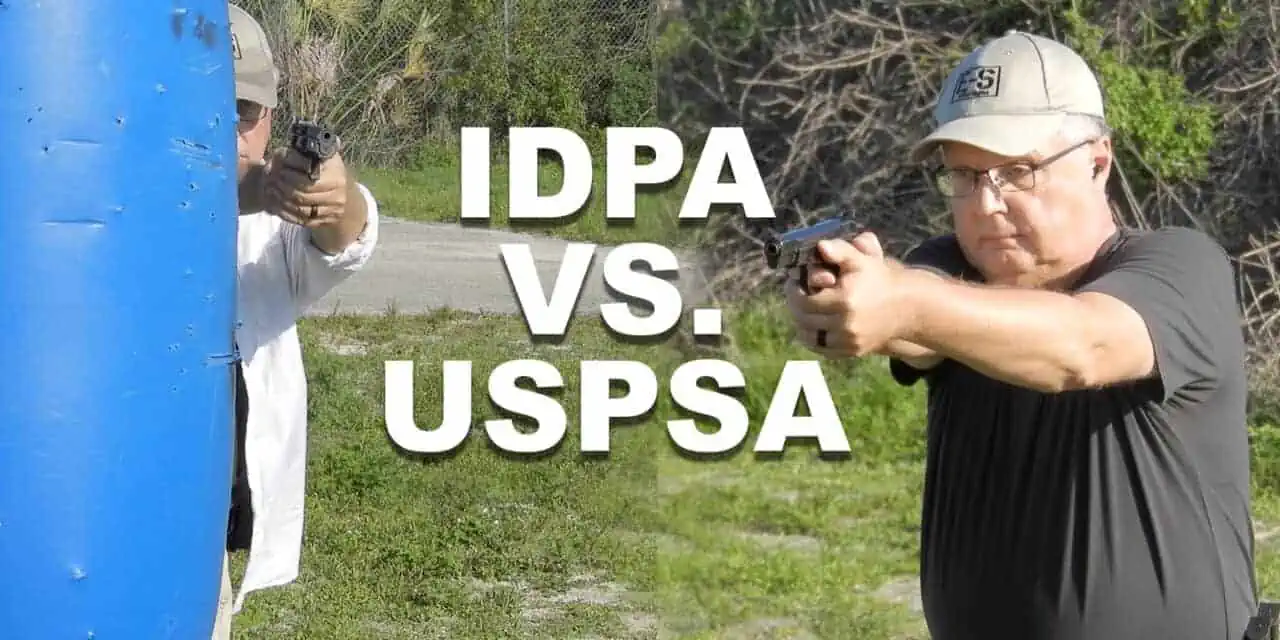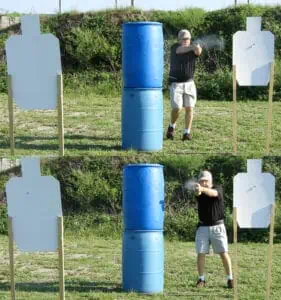Comparing IDPA vs USPSA
A practical shooting match is a fast and fun way to gain confidence with your defensive firearm of choice. Just as boxing or mixed martial arts tends to make you a better street fighter, competing in a practical pistol match helps you make better decisions when your life is literally on the line. In the U.S., two of the biggest practical shooting groups are the United States Practical Shooting Association (USPSA) and the International Defensive Pistol Association (IDPA). While the two sports share some common principles and can use the same gear, there are some fundamental differences with IDPA vs USPSA.
First, let’s talk about what they have in common. Both sports require some form of holster for your pistol, as well as a carrier for spare ammunition. There are systems in each sport that allow for competitors of similar skill level to compete against each other rather than matching up rookies against the best shooters on the range. The USPSA and the IDPA also sort out competitors by the type of gun they use, so higher-capacity semi-auto shooters aren’t competing with wheelguns.
IDPA and USPSA both have matches that consist of several stages. Targets are set up in a predefined area for you to shoot. Both sports have range officers who enforce the rules and make sure everyone stays safe. After shooting a stage, competitors earn points based on their accuracy. Both sports rely on the competitors to reset the stage for the next competitor. There are often “no shoot” targets and other penalty targets scattered throughout a course of fire. Finally, (with one exception) both sports favor the use of pistols that are chambered in something at least as powerful as 9mm Luger. Let’s take a look at some of the specific rules that cover USPSA.
USPSA Rules and Regulations
The United States Practical Shooting Association was formed in 1984 as an offshoot of IPSC. The founders of USPSA saw a need to move the sport in a direction that was better suited to shooters in the United States. So, they formed USPSA to cater to those needs.
USPSA pre-dates the explosion of expanded concealed carry laws in the U.S. As such, its focus tends to be more athletic. It is more suited to a “run and gun” style of competition than IDPA.
USPSA is also very open to advances in firearms technology. Guns in USPSA Open Division can have red dot optics, compensators, and all manner of gadgets on them and still be legal to shoot. They just have to fit within certain dimensional parameters.
USPSA’s Hit Factor Scoring
We measure scoring in USPSA in Hit Factor. This is simply the points you earned from your hits divided by the amount of time it took you to make them. In some USPSA divisions, they award more points on a stage if you are shooting a more powerful pistol, such as a .40 S&W or a 45 ACP.
Speaking of pistols, all the holsters and gear in USPSA tends to be focused on the sport itself. A good deal of the gear used in the sport is of little use outside of the shooting range. “Race guns,” or guns that are optimized for USPSA competitions, are definitely a thing in this sport. In USPSA, you’ll never draw a pistol from concealment, and you can reload your gun whenever and wherever you choose.
Enter IDPA
IDPA was created in 1996 to be a sport that would help return practical shooting to its practical roots. This shooting association requires cover garments that conceal your pistol and spare ammo. In IDPA, you cannot use race guns with red dots and they don’t allow compensators either.
9mm is the caliber of choice for most divisions in IDPA. USPSA gives a slight scoring advantage to guns shooting calibers larger than 9mm, but that isn’t the case in IDPA. .40 S&W and above are used mainly in the Custom Defensive Pistol (CDP) Division. That division is geared towards 1911-style guns.
IDPA Scoring
We score IDPA by taking the number of seconds needed to shoot the stage. Then, we add on seconds based on the hits on the targets. The lower total score is better. Hits on the center section of the target adds no time. Hits on the next section add 1 second. Push your shots farther outside, add three seconds. Any shots where you completely miss the target, add five seconds each.
This system places an emphasis on accuracy. If you blaze through a stage in record time but have poor hits on your targets, your score for the stage could be double (or triple!) your time.
Shooting IDPA vs USPSA
One of the biggest differences with IDPA vs USPSA is how you move through the stage as you shoot. IDPA requires the use of cover where it is available. You may not pass in front of a target before you shoot it. Also, if multiple targets are available at one time, you must engage the closer targets first. USPSA does not have these rules. On a USPSA stage, you can shoot targets as they appear when you are moving around the stage.
Which is better? USPSA or IDPA? Well, that really isn’t an either/or answer. I like to shoot both sports, as each of them offers something different and demands slightly different shooting skills. If you’re interested in honing your defensive skills, there are advantages to shooting IDPA vs USPSA. IDPA is a sport, but it is a sport you can more easily apply to “real world” situations than USPSA. Chances are good that your carry gun will be right at home at an IDPA match.
USPSA, on the other hand, places a higher emphasis on sport for sport’s sake than IDPA. That’s not to say there are no practical applications to shooting USPSA. Far from it. Some of our nation’s most elite soldiers are realizing that the practical shooting sports have many real-world applications. Competing in a USPSA match will definitely make you a better shooter, no matter when you need to use your gun.
Whichever you choose, you’ll find the differences between IDPA vs USPSA aren’t as important as the skills you’ll gain while at a match. In addition, every match I’ve ever shot has been very friendly to newcomers. You’ll soon find yourself surrounded by people who want to make sure you shoot your very best.





